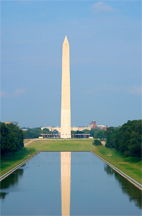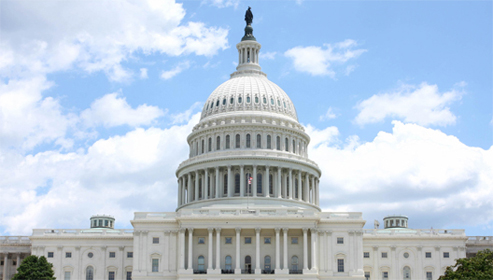INTRODUCTION /
WHAT IS NEOCLASSICISM?
What is Neoclassicism?
Neoclassicism was a revival of ancient forms and ideas that emerged in late 18th century Europe and North America. Enthusiasm for classical antiquity, stimulated by discoveries at Pompeii and archaeology, inspired political revolutions on two continents. In the United States, Neoclassicism influenced civics, arts and design, and ideas from the era of Thomas Jefferson (1743-1826) and Abraham Lincoln (1809-1865) through the first half of the 20th century. The classics grew into more than an ornament for the learned elite and cultivated. They permeated popular culture and education. By the end of the 19th century the nation’s art and literary giants had established an American Academy in Rome.
Neoclassicism was first transported to North America from Great Britain. Scholars, clergy, artists and statesmen had close ties to London and the European continent. The rise of libraries, economical mass printing, and engraved drawings helped to spread Neoclassical standards and forms across the Atlantic Ocean. From architecture to lawmaking, in many realms, Americans and the new nation used classical examples as models and guides.
The Neoclassical project was modern: an effort to imitate—and build on—ancient glory. Academies, publishers, libraries and museums in the United States and Europe pushed classical forms and ideas forward with accelerating speed and at all levels of society. Twentieth-century critics wrote off Neoclassicism’s fixed forms and ideas as stuffy and passé. This anti-classicism prevailed in thought and design after the middle of the 20th century.
In arts and government Neoclassicism admired order, simplicity, clarity, and reason; these concepts infused American thought, fine arts, literature, and politics well into the 20th century. From Plutarch to Aesop, classical stories were widely cycled in popular stories and maxims. Historian Caroline Winterer observes in her 2002 book, The Culture of Classicism, American Neoclassicism expressed itself in a "staggering variety" of ways. Classical allusions and authorities, Winterer notes, helped to define America's ethical, political, oratorical, artistic and educational ideals. "Given our devotion to more modern concerns today, it is difficult to grasp how dazzled Americans were by the ancient Greeks and Romans, how enthusiastically they quarried the classical past," she concludes.
Winterer on classical imagery and American ideas
For European and American opinion makers, clergy, and writers, Greco-Roman literature and philosophy were central to formal education; classical works were the common currency of cultural exchange. Neoclassicism stood at the center of humanistic learning, public symbolism, and revolutionary political thought. And it was a point of view and intellectual force in Boston and New England, New York and Philadelphia, Virginia and South Carolina, spreading across the continent in the 19th century, reified in colleges, courthouses and museums that look like Greek temples.
Neoclassical Aesthetics
With profound enthusiasm for the new aesthetic they were creating, 18th-century scholars, archaeologists, architects, and even political leaders examined newly discovered artifacts, not only manuscripts but also old pottery and coins, for example, looking for historical clues to what made a great civilization and culture. “There is but one way for the moderns to become great, and perhaps unequalled … by imitating the ancients,” the German historian Johann Winckelmann declared in his influential 1755 book, Thoughts on the Imitation of Greek Works in Painting and Sculpture.
Winckelmann’s History of the Art of Antiquity, published in 1764, provided a systematic survey of Greek art by date and style, Winckelmann is often thought to be the originator of art history as a scholarly discipline. Winckelmann’s immense influence throughout Europe shifted taste against baroque conventions and toward classical form.
For more about Johann Winckelmann
The Invention of Antiquity: an exhibition with photographs
Neoclassicism left an array of paintings, sculpture, buildings, and furniture freighted with inventive and sometimes radical forms.
Johann Winckelmann, Thomas Jefferson, and other classicists of the 18th century did not use the term Neoclassicism to describe the antique revival that they were living through. But the term is used today to describe a multivalent cultural phenomenon that revalued antiquity between 1750 and 1900. To define and categorize Neoclassicism, the art historian George Heard Hamilton stated in 1970:
The use of Greek and Roman forms for symbolic as well as functional purposes, which was a continuous and often dominant tendency in Western art for a century after 1750, has been called the Classic Revival, or Neoclassicism, and can be divided into two periods, with a Roman phase conspicuous until 1815 and a Greek one thereafter. The use of such forms was not always chronologically successive.
In 1922, the architectural historian Siegfried Giedion coined the term romantic classicism to describe the emotional side of Neoclassicism: the recreation of a distant, lost and idealized world. The Virgilian landscape with a Temple was a staple of classical pastoralism. Ancient statesmen became larger than life heroes. The ancient could even be connected to nature and the sublime, as with the eruption of Vesuvius. With the strict modeling of building and art works on ancient models, the classical world was imagined as a perfect and pure ideal executed in white marble.
Through the 19th century, artists and others made a conscious attempt to humanize the cooler, more cerebral aspects of pure Neoclassicism. Classical images could be expressly evocative and picturesque, as in the contemplation of ruins and the inexorable passage of time. American interest in antiquity went beyond Greece and Rome, encompassing the broader history of the Ancient Mediterranean, including Etruria, Carthage, Egypt, and Persia.
Early American concepts of the ancient Mediterranean
Along with the Classic Revival, there was fascination with ancient Egyptian culture, kindled in part by Napoleon’s Egyptian Campaign (1798-1801). Archaeologists, scholars and visitors throughout the 19th century spurred American interest. Cleopatra, the Pyramids, the Sphinx, mummies, and obelisks all became part of popular American consciousness and popular culture.
 Washington Monument, 1848-1884 |
|
The obelisk was both an Egyptian and Roman symbol of perpetuity and power. |
For more about the Washington Monument
Between the 1840s and 1880s, with many long interruptions, Americans built a colossal obelisk in the middle of the national capital, a symbolic fixture of ancient Egypt and Rome, and called it the Washington Monument.
Neoclassicism’s Constitutional Dimension
Neoclassicism was additionally a political phenomenon. In the late 18th century, spurred by classical ideas, Americans established a republican government modeled on Greek and Roman principles. This was a form of government that cherished liberty, using ancient models to try to reform polities, protect individuals, and constrain tyranny.
Classical models of government were influential in the creation of a constitutional republic, a radical and novel form of self-government modeled on antiquity. In essence, Americans borrowed and reshaped Roman government and civics in their political self-interest, in the process creating a modern republic. The Founders of the United States looked to the Greco-Roman past for successful political models and emotional inspiration. The Greeks and Romans had debated and developed the principles of justice, the rule of law, liberty, and due process. Ancient opponents of tyranny, monarchy, and aristocracy provided illustrations of heroism, as did classical advocates of the philosophical life. The 18th- and early 19th-century American view of the classical world was to admire the workings of republican government, not imperialism or unrestrained democratic rule.
American political leaders were looking for keys to successful and longstanding government that protected citizens against tyranny. In particular, they admired Greco-Roman achievements in political order and legal authority (including “limited government” and "rule of law").
From 1750 to 1900 English and American statesmen and constitutionalists regarded Roman models of law and jurisprudence as the foundations of the civilized world, a great achievement of enlightened liberalism, and as such, deserving of popular reverence. In politics and statesmanship, Neoclassicism often reflects the effort to connect contemporary greatness and accomplishments to the legendary achievements of larger-than-life Greek and Roman heroes. It is often a projection of its own ambitions on the classical past. Studying Neoclassicism gives us clues to what was in the minds of Americans as they set out to create a new and better form of political rule, one rooted in reason, liberty and self-government.
Defining Neoclassicism
According to the Art Institute of Chicago:
Neoclassicism is a term used to describe works of art that are influenced stylistically or thematically by Classical Greek and Roman sources. The origins of the Neoclassical style lie in the discovery of the ancient Roman cities of Herculaneum and Pompeii, which had been buried by the eruption of Mt. Vesuvius in A.D. 79. The preserved cultural artifacts of those cities educated and inspired European archaeologists, artists and collectors during the first half of the 18th century. The German art historian Johann Joachim Winckelmann’s extensive and enthusiastic writings about the achievements of Greek sculptors encouraged artists to pursue Classical forms and ideals as well.
European and American artists adopted Neoclassicism for aesthetic and political reasons, and the style flourished during the revolutionary periods in France and the United States. The appropriation of Classical forms suggested learning, democratic values, moral virtue, and a sophisticated appreciation of beauty, each considered essential components in the development of a nation. Painters, sculptors, architects, and decorative artists employed simple, flowing lines, restrained ornament, and idealized figures to impart their lofty aims to the public. American Neoclassical sculpture was produced primarily by artists such as Horatio Greenough, Hiram Powers, and Harriet Hosmer, who traveled to Rome and Florence during the first half of the 19th century to study with European masters.
To explain Neoclassicism, one course of study stresses three points of introduction:
- In aspirations, Neoclassicism idealizes purity of ancient Greece and republican Rome.
- Conviction runs through Neoclassicism that there are universals that embody permanent truths about what things are that can be discovered in the collected wisdom of antiquity.
- Classical ethics run deeply through the political and cultural aspirations of 18th and 19th century Americans.
Each of the words above in italics – purity, universals, and ethics – is defined, examined, and used to open class discussion and introduce the conceptual elements of Neoclassicism.
Consider the online Metropolitan Museum of Art overview of the Neoclassical style and its impact.
A survey of the Neoclassical style
Historian William Ziobro has developed a well regarded online syllabus called "Classical America":
Classical America: a course syllabus
Study Questions
- Identify Neoclassicism’s core ideals and explain how they bridge the arts, letters, and politics.
- How does Neoclassicism extend classicizing tendencies from the Renaissance and previous centuries? How is it different and new?
- How did Americans adapt the concepts of a republic, senate, rule of law, and capitol, borrowing them from ancient Rome?
- How is Neoclassicism part of larger American interest in the ancient Mediterranean?
- What is the "romantic" element of 18th- and 19th-century antiquarianism?
- In style and form how does Neoclassicism compare with the rococo that precedes it?
- How do Nicholas Biddle’s Andalusia (built between 1835-36) and McKim, Mead and White’s Washington Square Arch (1890-92) below embody Neoclassical forms?
- What are the purposes of each building? What are their prototypes?
- What emotions are they trying to convey through their antique references?
- Where do other temples and triumphal arches exist in the United States?
![]()
For Further Study
Recommended surveys, anthologies, texts, and monographs that cover Neoclassicism in the arts and other areas of culture:
Albert Boime, Art in an Age of Revolution, 1750-1800, Chicago, 1987.
Lorenz Eitner, ed. Neoclassicism and Romanticism, 1750-1850: Sources and Documents, vols. 1 and 2, Prentice Hall, 1970.
George Heard Hamilton, “Romantic Classicism,” Nineteenth and Twentieth Century Art, Abrams, 1970.
Hugh Honour, Neo-classicism, Penguin, 1977.
David Irwin, Neoclassicism, Phaidon, 1997.
Robert Rosenblum, Transformations in Late 18th-Century Art, Princeton, 1970.
William L. Vance, America's Rome, vol. 1: Classical Rome, Yale, 1989.
Caroline Winterer, The Culture of Classicism: Ancient Greece and Rome in American Intellectual Life 1780-1910, Johns Hopkins, 2002.
![]()


